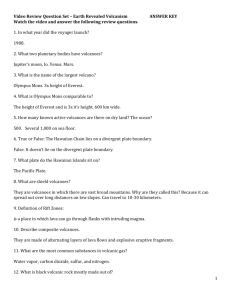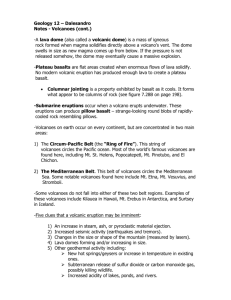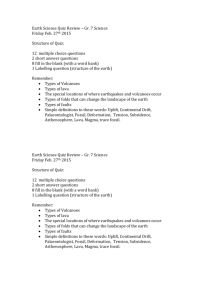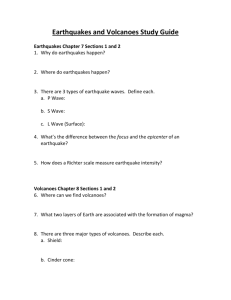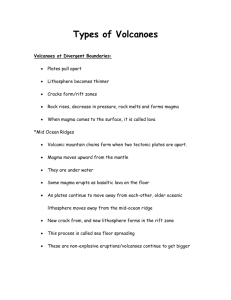Chapter 7 - Florida Gateway College
advertisement
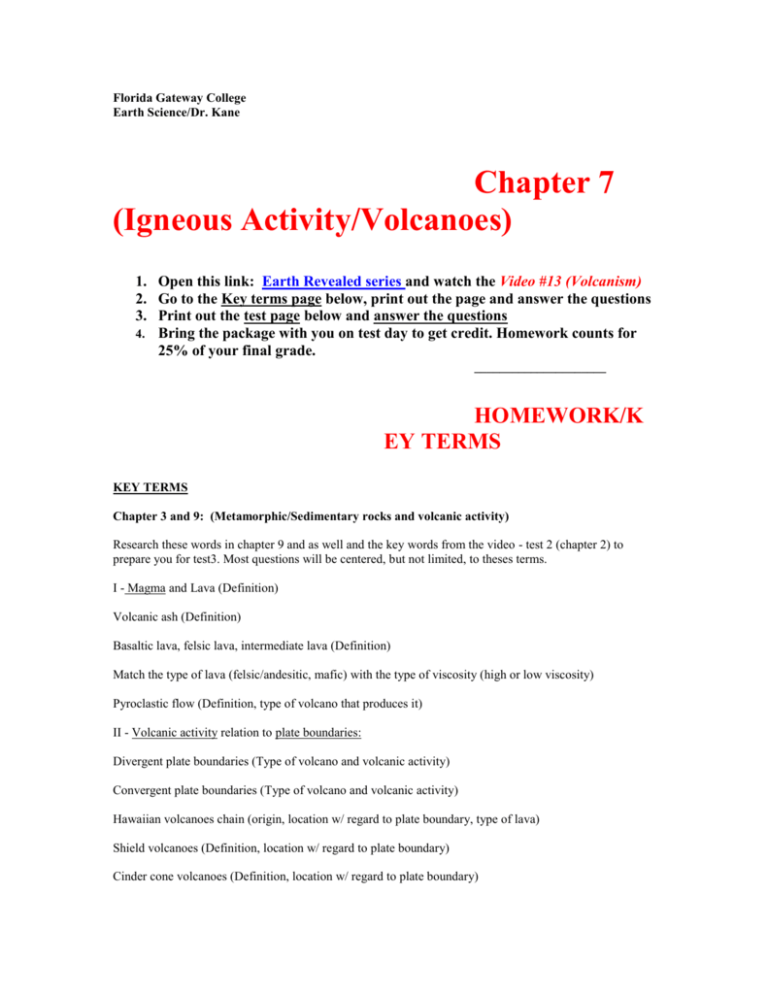
Florida Gateway College Earth Science/Dr. Kane Chapter 7 (Igneous Activity/Volcanoes) 1. Open this link: Earth Revealed series and watch the Video #13 (Volcanism) 2. Go to the Key terms page below, print out the page and answer the questions 3. Print out the test page below and answer the questions 4. Bring the package with you on test day to get credit. Homework counts for 25% of your final grade. _____________________ HOMEWORK/K EY TERMS KEY TERMS Chapter 3 and 9: (Metamorphic/Sedimentary rocks and volcanic activity) Research these words in chapter 9 and as well and the key words from the video - test 2 (chapter 2) to prepare you for test3. Most questions will be centered, but not limited, to theses terms. I - Magma and Lava (Definition) Volcanic ash (Definition) Basaltic lava, felsic lava, intermediate lava (Definition) Match the type of lava (felsic/andesitic, mafic) with the type of viscosity (high or low viscosity) Pyroclastic flow (Definition, type of volcano that produces it) II - Volcanic activity relation to plate boundaries: Divergent plate boundaries (Type of volcano and volcanic activity) Convergent plate boundaries (Type of volcano and volcanic activity) Hawaiian volcanoes chain (origin, location w/ regard to plate boundary, type of lava) Shield volcanoes (Definition, location w/ regard to plate boundary) Cinder cone volcanoes (Definition, location w/ regard to plate boundary) Hot-Spots (Definition, location w/ regard to plate boundary) Most explosive volcanoes relation to plate boundaries Composite volcanoes (Definition, location w/ regard to plate boundary, type of lava) Temperature and chemical composition relation to volcanic eruption Correlate silica content (SiO2) with viscosity of a magma/lava Correlate magma/lava viscosity with volcanic explosiveness. Role of gases in volcanic eruption Common gases in magma Pumice (Definition) Pahoehoe (Pah-hoy-hoy) (Definition, type of lava) AA (ah-ah) (Definition, type of lava) Obsidian (Definition, type of lava) Caldera (Definition) ______________________________________________________________________________________ ________________________________________ Essay Questions/ Chapters 7 1. Define viscosity of a magma 2. Explain how temperature and volatiles content affect magma viscosity 3. Why are composite cone volcanoes so explosive and so steep? Explain 4. Why do Hawaiian volcanoes form a chain? 5. Why are shield volcanoes so flat, broad and gently sloping? 6. Explain why Hawaiian volcanoes emit basaltic lava while the Pacific North West volcanoes produce andesitic lava. 7. What type of lava would you expect a continental volcanic arc volcano to emit? Why? 8. Name composite cone deadly arsenal HOMEWORK/PRAC TICE TEST Circle the correct answer 1. The definition of magma could be a. b. c. d. e. 2. Hard rock Molten rock in a magma chamber Acid rock All of the above None of the above The definition of lava could be a. b. c River of molten rock on a volcanic slope Hard rock like the Stone Mt Granite rock All of the above d. 3. A pyroclastic material is a mixture of _____________. a. b. c. d. 4. Fluid flows of basaltic lava Fluid flows of felsic lava Large thick and viscous pyroclastic flows Thick flows of andesitic to felsic lava Volcanoes of the Cascade Range are at a. b. c. d. e. 9. Mt. St. Helens, WA Kilauea, Hawaii Vesuvius, Italy Mt. Fuji, Japan Mt. Rainier, WA Shield volcanoes are produced by the accumulation of a. b. c. d. 8. Felsic to andesitic lava and pyroclastic material Basaltic lava All of these None of these One of these volcanoes is formed over a hot spot a. b. c. d. e. 7. Steep cones Broad gently sloping cones Caldera like structures only None of these Volcanoes at divergent plate boundary erupt mainly ___________. a. b. c. d 6. Ash and dust particles (fragments) Ash only Dust particles only None of these Volcanoes that erupt felsic/andesitic lava build _____________. a. b. c. d. 5. None of the above Divergent boundary Convergent boundary Hot spots All of these None of the above Continental volcanic arcs are found at a. Convergent plate boundaries b. c. d. 10. Volcanoes at convergent plate boundaries are more explosive than those on hot-spots because a. b. c. d. 11. 13. a. True _____________ b. False ____________ The most common gases in volcanic eruptions are Water, carbon dioxide, nitrogen Water, sulfur, methane Carbon dioxide, methane, nitrogen Water, oxygen, hydrogen None of the above Hawaiian volcanoes are an example of ________________.volcanoes a. b. c. d. e. 15. eruption Cinder cone Composite cone Shield No relation All volcanoes erupt gases a. b. c. d. e. 14. Their felsic to andesitic lava traps more gases that expand near the surface Their basaltic lava trap more gases that expand near the surface All of the above No relation whatsoever Most Volcanoes at convergent plate boundaries are ___________ volcanoes. a. b. c. d. 12. Divergent plate boundaries Transform fault None of the above Shield Cinder cone Composite cone All of the above None of the above Temperature and chemical composition do not influence the explosiveness of an a. True _____________ b. False ____________ 16. Explosive eruptions are produced by volcanoes which are______________. a. b. c. d. 17. 18. A pumice is formed from a viscous and highly gaseous magma 20. 21. 23. True ___________ b. False ___________ Viscosity Iron content Magnesium content Amount of gases present a and d A Pahoehoe (pah-hoy-hoy) is Hawaiian for a type of gases-free lava with jagged surface a. True _____________ b. False ____________ An AA (ah-ah) is Hawaiian for a wrinkled and ropy lava with dissolved gases a. True ____________ b. False ____________ A cinder cone is a type of volcano made entirely of a. b. c. d. 22. a. The explosiveness of an eruption is influenced by the ____________ of its lava. a. b. c. d. e. 19. Felsic/andesitic, cooler, and trap more gases Basaltic, hotter, trap less gases Felsic to basaltic, cooler, trap less gases What the difference anyway, all volcanoes are explosive to me Basaltic rock Felsic rock Fragments None of the above Shield volcanoes are a type of volcanoes that are broad and gently sloping a. True ___________ b. False ___________ Most volcanoes occur in these plate boundaries and settings a. b. c. d. e. 24. In a chain a volcanoes is formed above a hot spot when a. b. c. 25. 26. a. True ___________ b. False __________ The last largest eruption of Mount St. Helens, in Washington State was, 29. 30. May 18, 1988 May 18, 1980 June 18, 1980 I did not watch that video or I don’t remember The energy collected from volcanic activity is called a. b. c. d. e. 28. Many of the volcanoes can be active at the same time Only one is active at a time None of these A Caldera is a vast volcanic crater that has collapsed a. b. c. d. 27. Intraplate (Hot-spots) Convergent boundary Divergent boundary All of the above a and b only Geophysical energy Geothermal energy Geovolcanic energy Geologic energy None of the above A volcanic dome is a crater dome formed of obsidian a. True ___________ b. False __________ Explosive volcanoes build steep cones because their lava is fluid a. True _____________ b. False ____________ Composite cone volcanoes emit both lava and pyroclastic (ash and fragments) flows a. True ______________ b. 31. The protolith of marble in contact metamorphism is a. b. c. d. 32. Weathering and erosion Weathering, erosion, and compaction Cementation and compaction Erosion, cementation, and compaction Sandstone is a_____________ sedimentary rock a. b. c. d. 38. Temperature (Heat) Pressure a and b Lithification means ________________ of loose sediment into a sedimentary rock a. b. c. d. 37. Temperature (Heat) mainly Pressure mainly Both temperature and pressure equally Regional metamorphism involves only a. b. c. 36. Regional metamorphism Contact metamorphism Contact metamorphism involves only a. b. c. 35. Regional metamorphism Contact metamorphism Widespread metamorphism created along convergent plate boundary is called a. b. 34. Granite Limestone Slate Gneiss Metamorphism created when a cold rock is intruded by a hot magma body is called a. b. 33. False _____________ Chemical inorganic Detrital Chemical organic (biochemical) All of the above Limestone is a _________________sedimentary rock a. b. c. d. Chemical inorganic Detrital Chemical organic (biochemical) All of the above 39. Marble is a chemical inorganic sedimentary rock a. b. 40. True False Gypsum is a_____________ sedimentary rock a. b. c. d. e. Chemical inorganic Evaporite a and b Detrital Chemical organic (biochemical) ______________________________________________________________________________________ _________________________________________ Extra Credit Questions: (20%) Write answer on the back of scantron. 1. The texture of an igneous rock is determined by these factors a. b. c. d. e. 2. Name a slowly cooling, felsic intrusive, igneous rock: a. b. c. d. 3. Gabbro Basalt Granite Rhyolite Name a fast cooling, mafic extrusive, igneous rock filled with voids: a. b. c. d. e. 4. Cooling rate of the magma Amount of silica in the magma Amount of volatile present in the magma Amount of iron and magnesium in the magma a, b, and c Rhyolite Porphyritic basalt Vesicular basalt Obsidian Pumice Three factors play an important role in magma generation a. Heat increase, increase in water vapor, and oxygen b. Heat increase, drop in confining pressure, and increase in volatiles c. Water vapor, increase in amount of silica content, and volatiles d. Heat, heat, nothing but heat,… it’s getting hot in here e There are no three important factors, they work independently ______________________________________________________________________________________ _________________________________________
